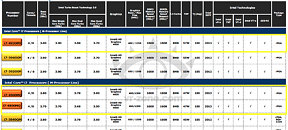- Joined
- Oct 9, 2007
- Messages
- 47,895 (7.38/day)
- Location
- Dublin, Ireland
| System Name | RBMK-1000 |
|---|---|
| Processor | AMD Ryzen 7 5700G |
| Motherboard | Gigabyte B550 AORUS Elite V2 |
| Cooling | DeepCool Gammax L240 V2 |
| Memory | 2x 16GB DDR4-3200 |
| Video Card(s) | Galax RTX 4070 Ti EX |
| Storage | Samsung 990 1TB |
| Display(s) | BenQ 1440p 60 Hz 27-inch |
| Case | Corsair Carbide 100R |
| Audio Device(s) | ASUS SupremeFX S1220A |
| Power Supply | Cooler Master MWE Gold 650W |
| Mouse | ASUS ROG Strix Impact |
| Keyboard | Gamdias Hermes E2 |
| Software | Windows 11 Pro |
Intel's Core i7 "Haswell" line of high-performance mobile processors will launch around roughly the same time as its first desktop counterparts, in April 2013. The April launch will consist of three models, which occupy conventional TDP ratings, making them fit for performance/gaming classes of notebooks, they're not quite Ultrabook-material.
Leading the pack is the Core i7-4930MX Extreme Edition, which enables nearly every component on the silicon. The quad-core chip features HyperThreading, which enables 8 logical CPUs, 3.00 GHz clock speed with 3.90 GHz maximum Turbo and 3.70 GHz all-core Turbo, new Intel HD 4600 Graphics clocked at 400 MHz with 1350 MHz maximum boost, 8 MB L3 cache, and 57W TDP.

Next up, is the Core i7-4900MQ, another quad-core chip featuring HyperThreading, 2.80 GHz clock speed with 3.80 GHz maximum Turbo and 3.60 GHz all-core Turbo, the same HD 4600 graphics as its bigger sibling, 8 MB L3 cache, and 47W TDP. Lastly, there's the Core i7-4800MQ, which features just a notch-lower clock speeds than the i7-4900MQ, at 2.70 GHz with 3.70 GHz maximum Turbo and 3.50 GHz all-core Turbo; but lower L3 cache amount, at 6 MB. The TDP is unaffected at 47W.
View at TechPowerUp Main Site
Leading the pack is the Core i7-4930MX Extreme Edition, which enables nearly every component on the silicon. The quad-core chip features HyperThreading, which enables 8 logical CPUs, 3.00 GHz clock speed with 3.90 GHz maximum Turbo and 3.70 GHz all-core Turbo, new Intel HD 4600 Graphics clocked at 400 MHz with 1350 MHz maximum boost, 8 MB L3 cache, and 57W TDP.

Next up, is the Core i7-4900MQ, another quad-core chip featuring HyperThreading, 2.80 GHz clock speed with 3.80 GHz maximum Turbo and 3.60 GHz all-core Turbo, the same HD 4600 graphics as its bigger sibling, 8 MB L3 cache, and 47W TDP. Lastly, there's the Core i7-4800MQ, which features just a notch-lower clock speeds than the i7-4900MQ, at 2.70 GHz with 3.70 GHz maximum Turbo and 3.50 GHz all-core Turbo; but lower L3 cache amount, at 6 MB. The TDP is unaffected at 47W.
View at TechPowerUp Main Site








